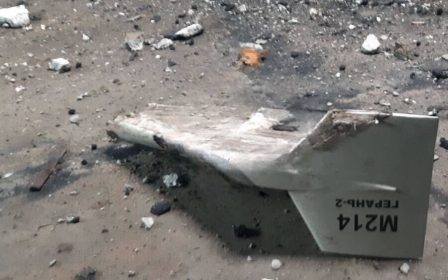Iranian drones contain parts from the US and potentially Israel, report says

The majority of parts found in downed Iranian drones in Ukraine are manufactured in the US, Europe and Western allies, according to new Ukrainian intelligence documents that call into question the success of US efforts to curtail the proliferation of Iranian drones.
The revelation puts a spotlight on Iran's success at building up a potent arms industry on the back of cheap, commercially available component parts that can be obtained from the West, while evading US sanctions.
Three-quarters of the component parts of Iranian drones bought by Russia and downed in Ukraine were made in the US, according to documents obtained by the Wall Street Journal from the Independent Anti-Corruption Commission (NAKO), a Kyiv-based nonprofit that verified research by Ukrainian military intelligence.
In one case, the researchers were able to study an Iranian Mohajer-6 drone that was brought down by Kyiv intact after being hacked mid-flight. About half the drone’s component parts were made by firms based in the US, while a third came from companies in Japan, according to the report.
"Iran is ready to meet with Ukraine at the level of technical experts and investigate drone or parts ownership claims," Iran's mission to the United Nations in New York told Middle East Eye, but refused to comment directly on the report.
The US has imposed debilitating sanctions against Iran and its economy. Washington has also put in place export controls on commercial parts that could be used in the manufacturing of weapons systems.
But experts warn that the simple makeup of Iran's drones and the accessibility of many parts on the commercial market makes it difficult to rein in their proliferation.
In October, the Wall Street Journal cited a confidential report prepared for the UK government documenting how Iran was able to supply drones to its Houthi allies in Yemen and evade sanctions using commercial companies to obtain parts.
Much of the technology found in Iranian drones shot down in Ukraine can be easily bought over the internet and shipped to Iran through intermediary countries, making them difficult to intercept.
The device allowing drone pilots to manoeuvre the Mohajer-6 drone, which was studied by Ukraine, was made by Japan's Tonegawa-Seiko Co.
Electronic components were manufactured by units of German-owned Infineon Technologies AG and Arizona-based Microchip Technology Inc.
"Without access to the device itself, we are unable to advise whether it is a Microchip product or counterfeit product, and if it is a Microchip product, how it ended up in this particular application," Brian Thorsen, a spokesman for Microchip Technology, told the WSJ.
The high-resolution telescopic infrared lens used in the Mohajer-6 for surveillance and targeting appeared identical to a model made by an Israeli firm, Ophir Optronics Solutions Ltd.
The US has also accused Iran of sourcing parts for its drone programme from China, with Beijing turning a blind eye to the sales that have helped the Islamic Republic aid its proxies in the region.
Drones deployed by Iran's proxies in Yemen, Lebanon and Iraq have been viewed as one of the most pressing security challenges in the Middle East by US officials. However, Russia's use of Iranian drones marks their first foray pnto a conventional battlefield and European territory.
One challenge to US efforts to combat Iran's drone programme, analysts say, is that many of Washington's allies - including in Europe - have refused to sign on to widespread sanctions.
On Tuesday, the US slapped new sanctions on companies in Iran, Russia and the UAE for facilitating the transfer and production of Iranian drones for use in Ukraine.
Tehran has admitted selling drones to Russia but denies it has done so since Moscow launched its invasion of Ukraine in February.
Middle East Eye propose une couverture et une analyse indépendantes et incomparables du Moyen-Orient, de l’Afrique du Nord et d’autres régions du monde. Pour en savoir plus sur la reprise de ce contenu et les frais qui s’appliquent, veuillez remplir ce formulaire [en anglais]. Pour en savoir plus sur MEE, cliquez ici [en anglais].





